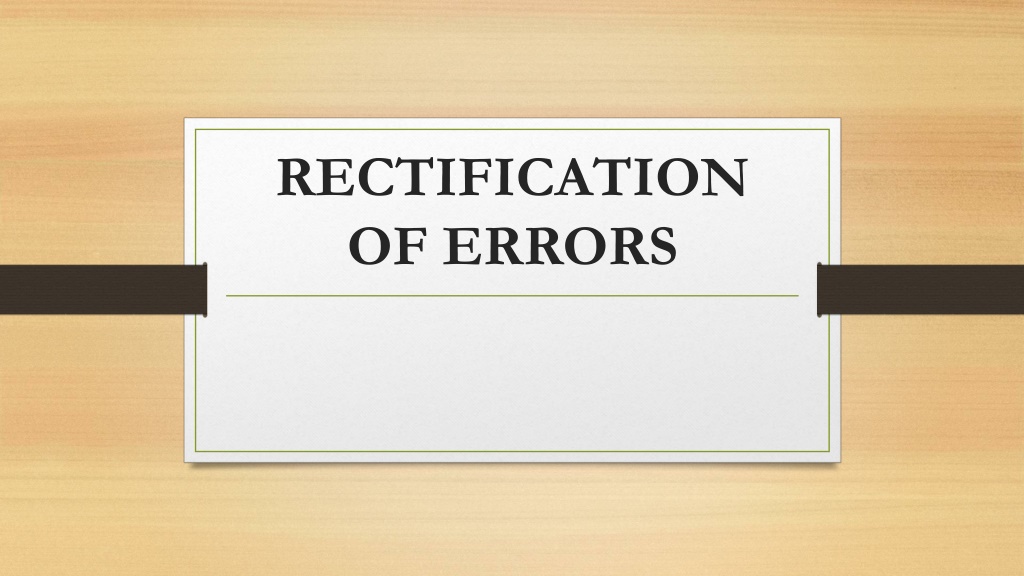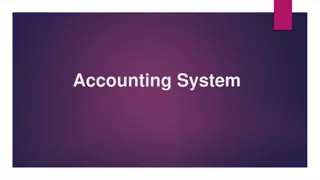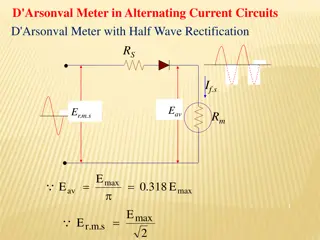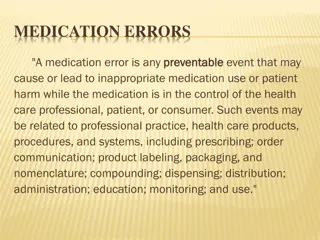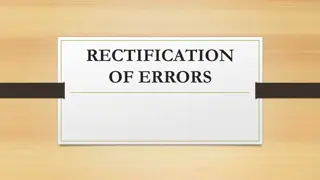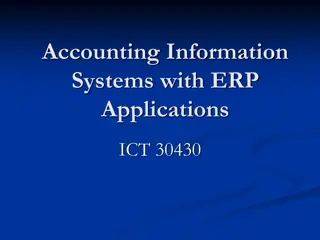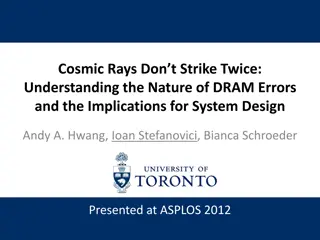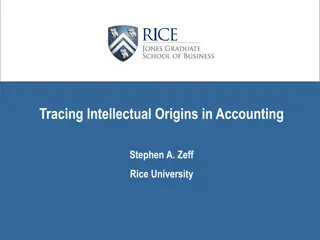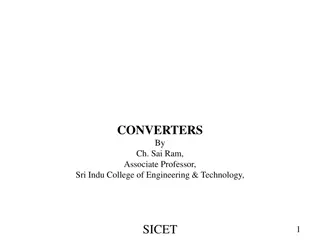Understanding Rectification of Errors in Accounting
Preparation of trial balance is essential for verifying the accuracy of accounting records, but it is not a conclusive proof of correctness. Rectification of errors is crucial for ensuring the true and fair presentation of a business's financial position. Types of errors include errors of omission, commission, principle, and compensating errors, each requiring specific identification and rectification methods.
Download Presentation

Please find below an Image/Link to download the presentation.
The content on the website is provided AS IS for your information and personal use only. It may not be sold, licensed, or shared on other websites without obtaining consent from the author. Download presentation by click this link. If you encounter any issues during the download, it is possible that the publisher has removed the file from their server.
E N D
Presentation Transcript
RECTIFICATION OF ERRORS
Preparation of trial balance is a way to check the arithmetic accuracy of recording and posting of transactions in the books of account but is it is not a conclusive proof. The tally of debit and credit side of trial balance signifies the accuracy of accounting records, this notion is only partially correct. Despite the agreement between debit and credit side accounting records may suffer from certain errors. But this agreement between the debit and credit side of trial balance, definitely signifies the presence of error in accounting records. Thus in both cases whether debit and credit side of trial balance tallies or not, error may present in accounting records.
To present the true and fair picture of profitability and financial position of business unit, rectification of error is necessary. Such errors are rectified by passing the entries of rectification. The objective of the process of rectification of error is to neutralize the impact of wrong entry and incorporate the correct impact in the accounting records. It needs and understanding of different type of accounting errors, ways to identify these errors and methods of rectification of errors.
Types of Errors Errors of Omission Errors of Commission Errors of Principle Compensating Errors
Errors of Omission: When a transaction is omitted from the books of accounts, such error is known as error of omission. Error of omission occurs either at the time of recording the transactions or posting these transaction to Ledger. When an error is occurred at the time of recording the transactions, it affects both sides of trial balance and therefore it becomes difficult to trace such error from the trial balance. For example, if a sales transaction of Rs. 12,000 has been omitted from recording in journal, it would neither affect the sales account nor cash account and the trial balance Tally would not be affected. Such error can be identified only at the time of presenting a statement of accounting to debtors or receiving the same from creditors. This error is also known as error of complete omission because in this case the entire transactions has been omitted from accounting records.
On the other hand, an omission at the time of posting, a transaction can be traced through trial balance since it may affect only one side of trial balance e.g. if posting of a credit purchase transaction from purchase book to debtors account is omitted, it would affect only one side of trial balance. Such error is known as error of partial omission. And can be traced through trial balance. Thus, error of omission are of two types: A. Error of complete omission B. Error of partial omission
Errors of Commission: Errors due to wrong carry forward of total at the time of recording a transaction or wrong posting from journal to ledger or wrong totaling of an account or wrong balancing of an account comes under the category of errors of omission. Since such errors may affect the agreement of trial balance, these errors can be easily identified. For example, if an amount of Rs. 750 is wrongly posted as Rs. 570, it would have an impact on agreement of trial balance. This error is mostly occurs due to clerical mistake, therefore it also false under the category of clerical nature error.
Errors of Principle: Error occurred due to violation of accounting Principles is known as error of principle. For example, if the person who is recording purchase of machinery, identifies purchase of machine as of revenue nature and debit the respective amount to the Purchase account, it would be known as errors of principle. It is difficult to locate such error since it may not affect the agreement of trial balance but such error seriously affects the financial results shown by financial statement, like in the above mention example through it would be difficult to locate the error but this error would reduce the amount of profit as well as value of assets in the balance sheet. A careful analysis of the business transaction at the time of recording the transaction would help in reducing such errors.
Compensating Errors: In case of compensating errors, two errors are committed in such a way that one error set off the effect of other error. For example purchase of Rs. 1000 is wrongly debited as Rs. 100 in one case, while in the other case purchase of Rs. 1100 has been overstated as Rs 2000. In this case, on one hand first error is reducing the purchase amount by Rs. 900 but simultaneously the second error is also increasing the Purchase amount by Rs. 900, thus the impact of first error on purchase price is being compensated by second error. Such error is known as compensating error and it does not affect the agreement of trial balance. Therefore, it is difficult to locate this error. Thus except error of commission rest other categories of errors do not affect the trial balance agreement and difficult to be located.
Location of Errors The possibility of identification of an error depends on the fact whether that error affect the agreement of trial balance or not. From this point of view errors can be categorized as those affecting the agreement of trial balance and those which do not affect the trial balance. Such errors should be located and rectified before final account preparation. Thus, from the point of view of locating and error can be categorised as follows; 1. Errors having impact on trial balance 2. Errors not having impact on trial balance
1. Errors having impact on trial balance: Error of commission comes under this category. Primarily this error can be located by checking the total of debit and credit side of the trial balance. The absence of agreement into sides of trial balance indicates the existence of errors. Once the existence of an error is detected following steps needs to be taken to locate such errors: Total of debit and credit side of trial balance should be re-calculated. The process of summarizing the transactions should be re-checked by comparing the account head or title and amount of trial balance with that of the ledger to detect the errors. The trial balance of current year should be compared with that of the previous year to check editions and detections and trees large unexpected and abnormal differences. Balance of individual accounts should be re-checked.
Posting of transactions from journal to ledger should be re-checked. Even if error has not been located, the difference between the debit and credit column should be calculated. If it is divisible by 2, it is possible that and amount equal to the half of difference is posted on Wrong side. To trees that amount all entries of that side that is debit or credit side should be scanned. Such differences in debit or credit side of the transaction may also be due to mission of posting a transaction with similar amount. To locate that error the accountant should recheck all posting of that side that is debit or credit side. If the difference of debit and credit side of trial balance is divided by 9 the error can be attributed to the transposition of figures or due to wrong placement of decimals for example rupee 180 is wrongly debited as rupee 108 the trial credit side balance would exceed by rupees 72 which is divided by 9. The same is also true in case of wrong placement of decimal.
2. Errors not having impact on trial balance: In case of error of omission, error of principle and compensating errors, it is possible that such errors have not affect the trial balance. It is very difficult to trace such errors. Such errors are identified at times when statement of account is either submitted to creditor or received from debtor or during internal or external audit or by chance.
Suspense Account Suspense account is an account wherein differences of trial balance is transferred temporarily. If the debit and credit side of trial balance is not in agreement and it is also not possible to locate the errors despite all efforts, the difference amount of trial balance is transferred to the suspense account. This account is maintained till the time, one could not locate error. As soon as errors related to suspense account are located weather at the beginning or during an accounting year, the suspense account should be closed by entering a reverse journal entry.
